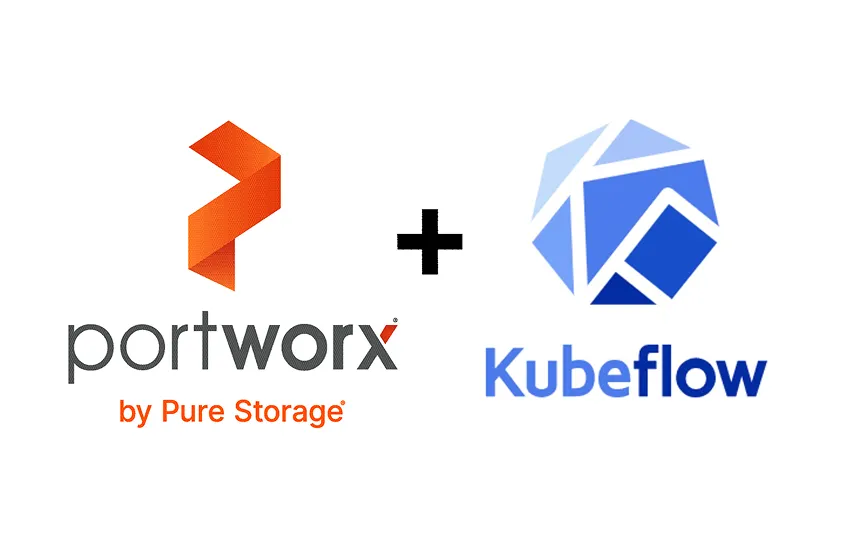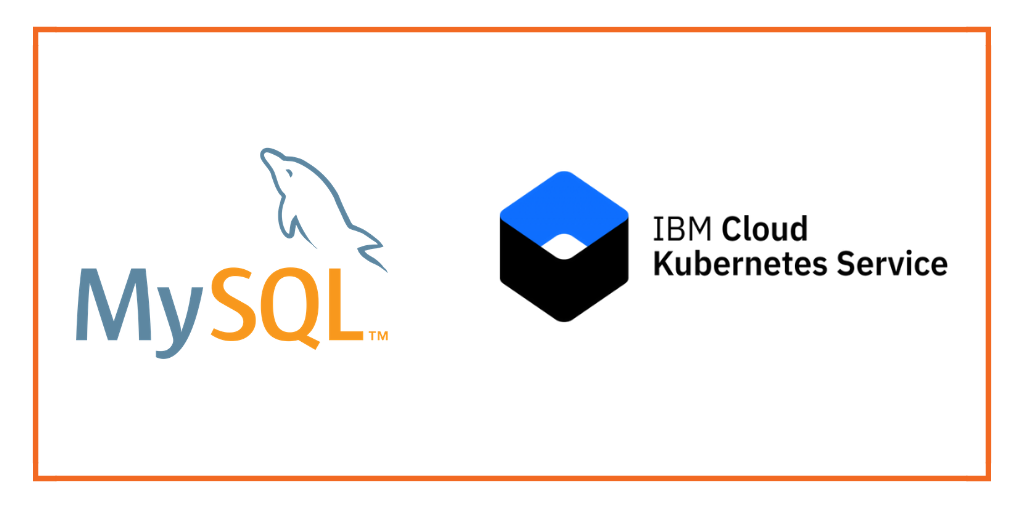
This post is part of our ongoing series on running MySQL on Kubernetes. We’ve published a number of articles about running MySQL on Kubernetes for specific platforms and for specific use cases. If you are looking for a specific Kubernetes platform, check out these related articles.
Running HA MySQL on Azure Kubernetes Service (AKS)
Running HA MySQL on Google Kubernetes Engine (GKE)
Running HA MySQL on Amazon Elastic Container Service for Kubernetes (EKS)
Running HA MySQL on Red Hat OpenShift
Running HA MySQL on Rancher Kubernetes Engine (RKE)
How to Backup and Restore MySQL on Red Hat OpenShift
Running HA MySQL on IBM Cloud Private
Kubernetes Persistent Volume Tutorial by Portworx
And now, onto the post…
IBM Cloud Kubernetes Service is a managed Kubernetes offering running in IBM Cloud. It is designed to deliver powerful tools, intuitive user experience, and built-in security for rapid delivery of applications that can be bound to cloud services related to IBM Watson, IoT, DevOps, and data analytics. As a CNCF-certified Kubernetes provider, IBM Cloud Kubernetes Service provides intelligent scheduling, self-healing, horizontal scaling, service discovery and load balancing, automated rollouts and rollbacks, and secret and configuration management. The service also has advanced capabilities around simplified cluster management, container security, and isolation policies, the ability to design a cluster with a custom configuration and integrated operational tools for consistency in deployment.
Portworx is a Kubernetes storage and data management platform that enables enterprises to confidently run mission-critical data services on IBM Cloud Kubernetes Service (as well as IBM Cloud Private). The addition of primitives (such as stateful sets and persistent volumes) to Kubernetes has made it possible, in theory, to run stateful services like databases on Kubernetes. But, these primitives alone do not address the core business challenges associated with running data-rich applications on Kubernetes: high availability, backup and recovery, data security, SLA-management, and more. Portworx provides a single data-management layer for all stateful services that directly addresses these challenging topics.
I’m really excited to work with Portworx and Janakiram MSV (@janakiramm), architect and advisor with Portworx, on this tutorial. The rest of the blog was authored by Jani.
Tutorial
This tutorial is a walk-through of the steps involved in deploying and managing a highly available MySQL cluster on IBM Cloud Kubernetes Service (IKS).
In summary, to run HA MySQL on IKS you need to:
- Launch an IKS cluster running on bare metal servers with software-defined storage (SDS)
- Install cloud native storage solution like Portworx as a Daemonset on IKS
- Create a storage class defining your storage requirements like replication factor, snapshot policy, and performance profile
- Deploy MySQL using Kubernetes
- Test failover by killing or cordoning node in your cluster
- Expanding the volume size dynamically
- Perform backup and restore through snapshots
Launching an IKS Cluster
For running stateful workloads in a production environment backed by Portworx, it is highly recommended to launch an IKS cluster based on bare metal servers and software-defined storage. The minimum requirements of a worker node to successfully run Portworx include:
- 4 CPU cores
- 4GB memory
- 128GB of raw unformatted storage
- 10Gbps network speed
For details on launching a Kubernetes cluster with bare metal worker nodes, please refer to the documentation of IBM Cloud Kubernetes Service.
We are using an IKS cluster with 4 nodes out of which 3 nodes are running bare metal servers with SDS based on the instance type ms2c.4x32.1.9tb.ssd.encrypted. Only these machines that meet the prerequisite would be used by Portworx.

When we filter the nodes based on the label, we see the below nodes:
$ kubectl get nodes -l beta.kubernetes.io/instance-type=ms2c.4x32.1.9tb.ssd.encrypted NAME STATUS ROLES AGE VERSION 10.177.26.18 Ready <none> 4d7h v1.13.2+IKS 10.185.22.28 Ready <none> 4d7h v1.13.2+IKS 10.73.90.131 Ready <none> 4d3h v1.13.2+IKS
To exclude nodes that don’t meet Portworx prerequisites, you can apply a label to skip the installation of Portworx. For example, the below command applies a label on the node with name 10.185.22.14 which doesn’t run on a bare metal server.
$ kubectl label nodes 10.185.22.14 px/enabled=false --overwrite
Installing Portworx in IKS
Installing Portworx on IKS is not very different from installing it on any other Kubernetes cluster. It is recommended that you create an etcd instance through Compose for etcd. You can use the Helm Chart to install Portworx cluster in IKS. Portworx documentation for IKS has the prerequisites and instructions to install and configure Portworx, STORK, and other components.
At the end of the installation, we will have Portworx Daemonset running on the nodes excluding those that are filtered out in the previous step.

Once the IKS cluster is up and running, and Portworx is installed and configured, we will deploy a highly available MySQL database.
Creating a Kubernetes storage class for MySQL
Once the IKS cluster is up and running, and Portworx is installed and configured, we will deploy a highly available MySQL database.
Through Kubernetes storage class objects, an admin can define different classes of Portworx volumes that are offered in a cluster. These classes will be used during the dynamic provisioning of volumes. The Storage Class defines the replication factor, I/O profile (e.g., for a database or a CMS), and priority (e.g., SSD or HDD). These parameters impact the availability and throughput of workloads and can be specified for each volume. This is important because a production database will have different requirements than a development Jenkins cluster.
In this example, the storage class that we deploy has a replication factor of 3 with I/O profile set to “db,” and priority set to “high.” This means that the storage will be optimized for low latency database workloads like MySQL and automatically placed on the highest performance storage available in the cluster. Notice that we also mention the filesystem, xfs in the storage class.
$ cat > px-mysql-sc.yaml << EOF
kind: StorageClass
apiVersion: storage.k8s.io/v1beta1
metadata:
name: px-ha-sc
provisioner: kubernetes.io/portworx-volume
parameters:
repl: "3"
io_profile: "db_remote"
priority_io: "high"
fs: "xfs"
EOF
$ kubectl create -f px-mysql-sc.yaml storageclass.storage.k8s.io "px-ha-sc" created
$ kubectl get sc NAME PROVISIONER AGE default ibm.io/ibmc-file 7d2h ibmc-file-bronze (default) ibm.io/ibmc-file 7d2h ibmc-file-custom ibm.io/ibmc-file 7d2h ibmc-file-gold ibm.io/ibmc-file 7d2h ibmc-file-retain-bronze ibm.io/ibmc-file 7d2h ibmc-file-retain-custom ibm.io/ibmc-file 7d2h ibmc-file-retain-gold ibm.io/ibmc-file 7d2h ibmc-file-retain-silver ibm.io/ibmc-file 7d2h ibmc-file-silver ibm.io/ibmc-file 7d2h portworx-db-sc kubernetes.io/portworx-volume 3m54s portworx-db2-sc kubernetes.io/portworx-volume 3m54s portworx-null-sc kubernetes.io/portworx-volume 3m54s portworx-shared-sc kubernetes.io/portworx-volume 3m54s px-ha-sc kubernetes.io/portworx-volume 9s stork-snapshot-sc stork-snapshot 3m54s
Creating a MySQL PVC on Kubernetes
We can now create a Persistent Volume Claim (PVC) based on the Storage Class. Thanks to dynamic provisioning, the claims will be created without explicitly provisioning Persistent Volume (PV).
$ cat > px-mysql-pvc.yaml << EOF
kind: PersistentVolumeClaim
apiVersion: v1
metadata:
name: px-mysql-pvc
annotations:
volume.beta.kubernetes.io/storage-class: px-ha-sc
spec:
accessModes:
- ReadWriteOnce
resources:
requests:
storage: 1Gi
EOF
$ kubectl create -f px-mysql-pvc.yaml
persistentvolumeclaim/px-mysql-pvc created
$ kubectl get pvc
NAME STATUS VOLUME CAPACITY ACCESS MODES STORAGECLASS AGE
px-mysql-pvc Bound pvc-909a51d5-31a3-11e9-aa17-32e4785d9ba0 1Gi RWO px-ha-sc 8s
Deploying MySQL on IKS
Finally, let’s create a MySQL instance as a Kubernetes deployment object. For simplicity’s sake, we will just be deploying a single MySQL pod. Because Portworx provides synchronous replication for High Availability, a single MySQL instance might be the best deployment option for your MySQL database. Portworx can also provide backing volumes for multi-node MySQL cluster. The choice is yours.
$ cat > px-mysql-app.yaml << EOF
apiVersion: apps/v1
kind: Deployment
metadata:
name: mysql
spec:
strategy:
rollingUpdate:
maxSurge: 1
maxUnavailable: 1
type: RollingUpdate
replicas: 1
selector:
matchLabels:
app: mysql
template:
metadata:
labels:
app: mysql
spec:
schedulerName: stork
containers:
- name: mysql
image: mysql:5.6
imagePullPolicy: "Always"
env:
- name: MYSQL_ROOT_PASSWORD
value: password
ports:
- containerPort: 3306
volumeMounts:
- mountPath: /var/lib/mysql
name: mysql-data
volumes:
- name: mysql-data
persistentVolumeClaim:
claimName: px-mysql-pvc
EOF
$ kubectl create -f px-mysql-app.yaml deployment.extensions/mysql created
The MySQL deployment defined above is explicitly associated with the PVC, px-mysql-pvc created in the previous step.
This deployment creates a single pod running MySQL backed by Portworx.
$ kubectl get pods NAME READY STATUS RESTARTS AGE mysql-76d5c4b78b-hqjcs 1/1 Running 0 14s
We can inspect the Portworx volume by accessing the pxctl tool running with the MySQL pod.
$ VOL=`kubectl get pvc | grep px-mysql-pvc | awk '{print $3}'`
$ PX_POD=$(kubectl get pods -l name=portworx -n kube-system -o jsonpath='{.items[0].metadata.name}')
$ kubectl exec -it $PX_POD -n kube-system -- /opt/pwx/bin/pxctl volume inspect ${VOL}
Volume : 781585151816423188
Name : pvc-909a51d5-31a3-11e9-aa17-32e4785d9ba0
Size : 1.0 GiB
Format : ext4
HA : 3
IO Priority : LOW
Creation time : Feb 16 04:30:18 UTC 2019
Shared : no
Status : up
State : Attached: 6ab3face-615f-4cc7-bcfa-a1872d006e34 (10.185.22.29)
Device Path : /dev/pxd/pxd781585151816423188
Labels : namespace=default,pvc=px-mysql-pvc
Reads : 12
Reads MS : 36
Bytes Read : 49152
Writes : 609
Writes MS : 10256
Bytes Written : 146239488
IOs in progress : 0
Bytes used : 10 MiB
Replica sets on nodes:
Set 0
Node : 10.73.90.131 (Pool 0)
Node : 10.177.26.18 (Pool 0)
Node : 10.185.22.29 (Pool 0)
Replication Status : Up
Volume consumers :
- Name : mysql-76d5c4b78b-hqjcs (bb30c604-31a3-11e9-930d-4e511e6b17c9) (Pod)
Namespace : default
Running on : 10.185.22.29
Controlled by : mysql-76d5c4b78b (ReplicaSet)
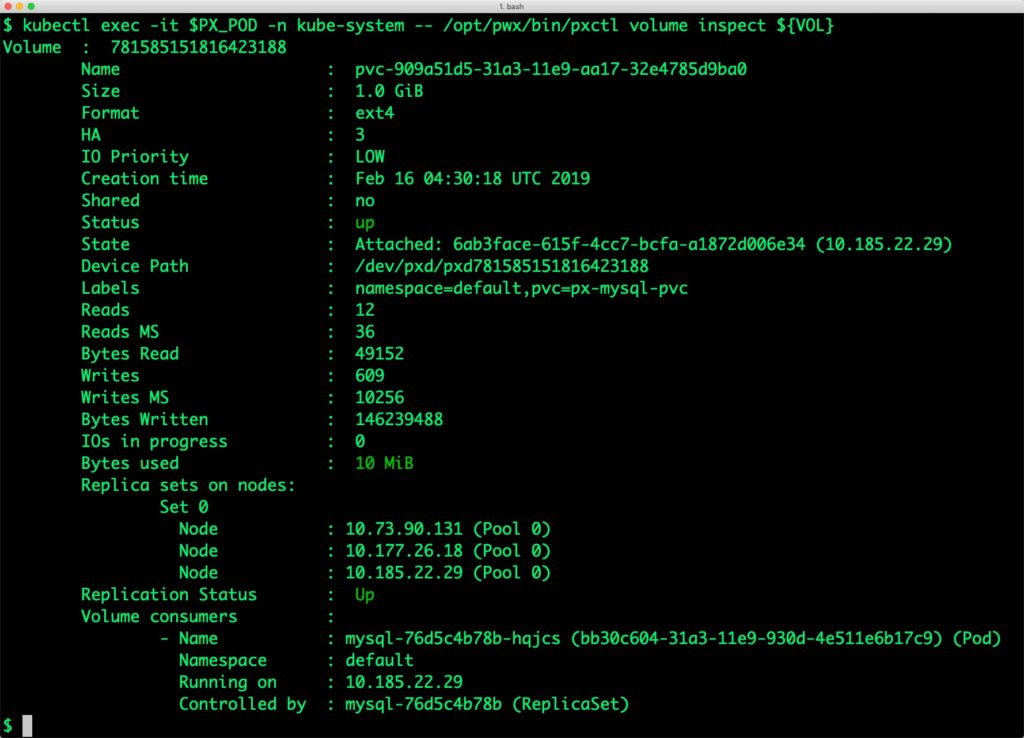
The output from the above command confirms the creation of volumes that are backing MySQL database instance.
Failing over MySQL pod on Kubernetes
Populating sample data
Let’s populate the database with some sample data.
We will first find the pod that’s running MySQL to access the shell.
$ POD=`kubectl get pods -l app=mysql | grep Running | grep 1/1 | awk '{print $1}'`
$ kubectl exec -it $POD -- mysql -uroot -ppassword
Welcome to the MySQL monitor. Commands end with ; or \g.
Your MySQL connection id is 1
Server version: 5.6.40 MySQL Community Server (GPL)
Copyright (c) 2000, 2018, Oracle and/or its affiliates. All rights reserved.
Oracle is a registered trademark of Oracle Corporation and/or its
affiliates. Other names may be trademarks of their respective
owners.
Type 'help;' or '\h' for help. Type '\c' to clear the current input statement.
mysql>
Now that we are inside the shell, we can populate create a sample database and table.
mysql> CREATE DATABASE `classicmodels`;
mysql> USE `classicmodels`;
mysql> CREATE TABLE `offices` (
`officeCode` varchar(10) NOT NULL,
`city` varchar(50) NOT NULL,
`phone` varchar(50) NOT NULL,
`addressLine1` varchar(50) NOT NULL,
`addressLine2` varchar(50) DEFAULT NULL,
`state` varchar(50) DEFAULT NULL,
`country` varchar(50) NOT NULL,
`postalCode` varchar(15) NOT NULL,
`territory` varchar(10) NOT NULL,
PRIMARY KEY (`officeCode`)
) ENGINE=InnoDB DEFAULT CHARSET=latin1;
mysql> insert into `offices`(`officeCode`,`city`,`phone`,`addressLine1`,`addressLine2`,`state`,`country`,`postalCode`,`territory`) values
('1','San Francisco','+1 650 219 4782','100 Market Street','Suite 300','CA','USA','94080','NA'),
('2','Boston','+1 215 837 0825','1550 Court Place','Suite 102','MA','USA','02107','NA'),
('3','NYC','+1 212 555 3000','523 East 53rd Street','apt. 5A','NY','USA','10022','NA'),
('4','Paris','+33 14 723 4404','43 Rue Jouffroy D\'abbans',NULL,NULL,'France','75017','EMEA'),
('5','Tokyo','+81 33 224 5000','4-1 Kioicho',NULL,'Chiyoda-Ku','Japan','102-8578','Japan'),
('6','Sydney','+61 2 9264 2451','5-11 Wentworth Avenue','Floor #2',NULL,'Australia','NSW 2010','APAC'),
('7','London','+44 20 7877 2041','25 Old Broad Street','Level 7',NULL,'UK','EC2N 1HN','EMEA');
Let’s run a few queries on the table.
mysql> select `officeCode`,`city`,`phone`,`addressLine1`,`city` from `offices`; +------------+---------------+------------------+--------------------------+---------------+ | officeCode | city | phone | addressLine1 | city | +------------+---------------+------------------+--------------------------+---------------+ | 1 | San Francisco | +1 650 219 4782 | 100 Market Street | San Francisco | | 2 | Boston | +1 215 837 0825 | 1550 Court Place | Boston | | 3 | NYC | +1 212 555 3000 | 523 East 53rd Street | NYC | | 4 | Paris | +33 14 723 4404 | 43 Rue Jouffroy D'abbans | Paris | | 5 | Tokyo | +81 33 224 5000 | 4-1 Kioicho | Tokyo | | 6 | Sydney | +61 2 9264 2451 | 5-11 Wentworth Avenue | Sydney | | 7 | London | +44 20 7877 2041 | 25 Old Broad Street | London | +------------+---------------+------------------+--------------------------+---------------+ 7 rows in set (0.01 sec)
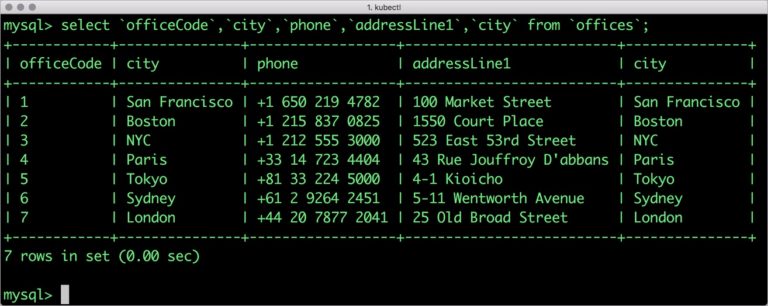
Find all the offices in the USA.
mysql> select `officeCode`, `city`, `phone` from `offices` where `country` = "USA"; +------------+---------------+-----------------+ | officeCode | city | phone | +------------+---------------+-----------------+ | 1 | San Francisco | +1 650 219 4782 | | 2 | Boston | +1 215 837 0825 | | 3 | NYC | +1 212 555 3000 | +------------+---------------+-----------------+ 3 rows in set (0.00 sec)
Exit from the MySQL shell to return to the host.
Simulating node failure
Now, let’s simulate the node failure by cordoning off the node on which MySQL is running.
$ NODE=`kubectl get pods -l app=mysql -o wide | grep -v NAME | awk '{print $7}'`
$ kubectl cordon ${NODE}
node/10.185.22.29 cordoned
The above command disabled scheduling on one of the nodes.
$ kubectl get nodes NAME STATUS ROLES AGE VERSION NAME STATUS ROLES AGE VERSION 10.177.26.18 Ready 8d v1.13.2+IKS 10.185.22.14 Ready 8d v1.13.2+IKS 10.185.22.29 Ready,SchedulingDisabled 6h48m v1.13.2+IKS 10.73.90.131 Ready 8d v1.13.2+IKS
Now, let’s go ahead and delete the MySQL pod.
$ POD=`kubectl get pods -l app=mysql -o wide | grep -v NAME | awk '{print $1}'`
$ kubectl delete pod ${POD}
pod "mysql-76d5c4b78b-hqjcs" deleted
As soon as the pod is deleted, it is relocated to the node with the replicated data. STorage ORchestrator for Kubernetes (STORK), Portworx’s custom storage scheduler allows co-locating the pod on the exact node where the data is stored. It ensures that an appropriate node is selected for scheduling the pod.
Let’s verify this by running the below command. We will notice that a new pod has been created and scheduled in a different node.
$ kubectl get pods -l app=mysql -o wide NAME READY STATUS RESTARTS AGE IP NODE NOMINATED NODE READINESS GATES mysql-76d5c4b78b-vgwk6 1/1 Running 0 17s 172.30.59.91 10.177.26.18
$ kubectl uncordon ${NODE}
node/10.185.22.29 uncordoned
Finally, let’s verify that the data is still available.
Verifying that the data is intact
Let’s find the pod name and run the ‘exec’ command, and then access the MySQL shell.
$ POD=`kubectl get pods -l app=mysql -o wide | grep -v NAME | awk '{print $1}'`
$ kubectl exec -it $POD -- mysql -uroot -ppassword
Welcome to the MySQL monitor. Commands end with ; or \g.
Your MySQL connection id is 1
Server version: 5.6.40 MySQL Community Server (GPL)
Copyright (c) 2000, 2018, Oracle and/or its affiliates. All rights reserved.
Oracle is a registered trademark of Oracle Corporation and/or its
affiliates. Other names may be trademarks of their respective
owners.
Type 'help;' or '\h' for help. Type '\c' to clear the current input statement.
mysql>
We will query the database to verify that the data is intact.
mysql> USE `classicmodels`; mysql> select `officeCode`, `city`, `phone` from `offices` where `country` = "USA"; +------------+---------------+-----------------+ | officeCode | city | phone | +------------+---------------+-----------------+ | 1 | San Francisco | +1 650 219 4782 | | 2 | Boston | +1 215 837 0825 | | 3 | NYC | +1 212 555 3000 | +------------+---------------+-----------------+ 3 rows in set (0.00 sec)
Observe that the database table is still there and all the content is intact! Exit from the client shell to return to the host.
Performing Storage Operations on MySQL
After testing end-to-end failover of the database, let’s perform StorageOps on our IKS cluster.
Expanding the Kubernetes Volume with no downtime
Currently, the Portworx volume that we created at the beginning is of 1Gib size. We will now expand it to double the storage capacity.
First, let’s get the volume name and inspect it through the pxctl tool.
$ VOL=`kubectl get pvc | grep px-mysql-pvc | awk '{print $3}'`
$ PX_POD=$(kubectl get pods -l name=portworx -n kube-system -o jsonpath='{.items[0].metadata.name}')
$ kubectl exec -it $PX_POD -n kube-system -- /opt/pwx/bin/pxctl volume inspect ${VOL}
Volume : 781585151816423188
Name : pvc-909a51d5-31a3-11e9-aa17-32e4785d9ba0
Size : 1.0 GiB
Format : ext4
HA : 3
IO Priority : LOW
Creation time : Feb 16 04:30:18 UTC 2019
Shared : no
Status : up
State : Attached: d7f53ebb-0d02-4ba4-b689-2f335e8f9379 (10.177.26.18)
Device Path : /dev/pxd/pxd781585151816423188
Labels : namespace=default,pvc=px-mysql-pvc
Reads : 178
Reads MS : 400
Bytes Read : 6422528
Writes : 26
Writes MS : 164
Bytes Written : 294912
IOs in progress : 0
Bytes used : 17 MiB
Replica sets on nodes:
Set 0
Node : 10.73.90.131 (Pool 0)
Node : 10.177.26.18 (Pool 0)
Node : 10.185.22.29 (Pool 0)
Replication Status : Up
Volume consumers :
- Name : mysql-76d5c4b78b-vgwk6 (b1094e0f-31a4-11e9-930d-4e511e6b17c9) (Pod)
Namespace : default
Running on : 10.177.26.18
Controlled by : mysql-76d5c4b78b (ReplicaSet)
Notice the current Portworx volume. It is 1GiB. Let’s expand it to 2GiB.
$ kubectl exec -it $PX_POD -n kube-system -- /opt/pwx/bin/pxctl volume update $VOL --size=2 Update Volume: Volume update successful for volume pvc-909a51d5-31a3-11e9-aa17-32e4785d9ba0
Check the new volume size.
kubectl exec -it $PX_POD -n kube-system -- /opt/pwx/bin/pxctl volume inspect ${VOL}
Volume : 781585151816423188
Name : pvc-909a51d5-31a3-11e9-aa17-32e4785d9ba0
Size : 2.0 GiB
Format : ext4
HA : 3
IO Priority : LOW
Creation time : Feb 16 04:30:18 UTC 2019
Shared : no
Status : up
State : Attached: d7f53ebb-0d02-4ba4-b689-2f335e8f9379 (10.177.26.18)
Device Path : /dev/pxd/pxd781585151816423188
Labels : namespace=default,pvc=px-mysql-pvc
Reads : 253
Reads MS : 624
Bytes Read : 6729728
Writes : 46
Writes MS : 280
Bytes Written : 1212416
IOs in progress : 0
Bytes used : 17 MiB
Replica sets on nodes:
Set 0
Node : 10.73.90.131 (Pool 0)
Node : 10.177.26.18 (Pool 0)
Node : 10.185.22.29 (Pool 0)
Replication Status : Up
Volume consumers :
- Name : mysql-76d5c4b78b-vgwk6 (b1094e0f-31a4-11e9-930d-4e511e6b17c9) (Pod)
Namespace : default
Running on : 10.177.26.18
Controlled by : mysql-76d5c4b78b (ReplicaSet)
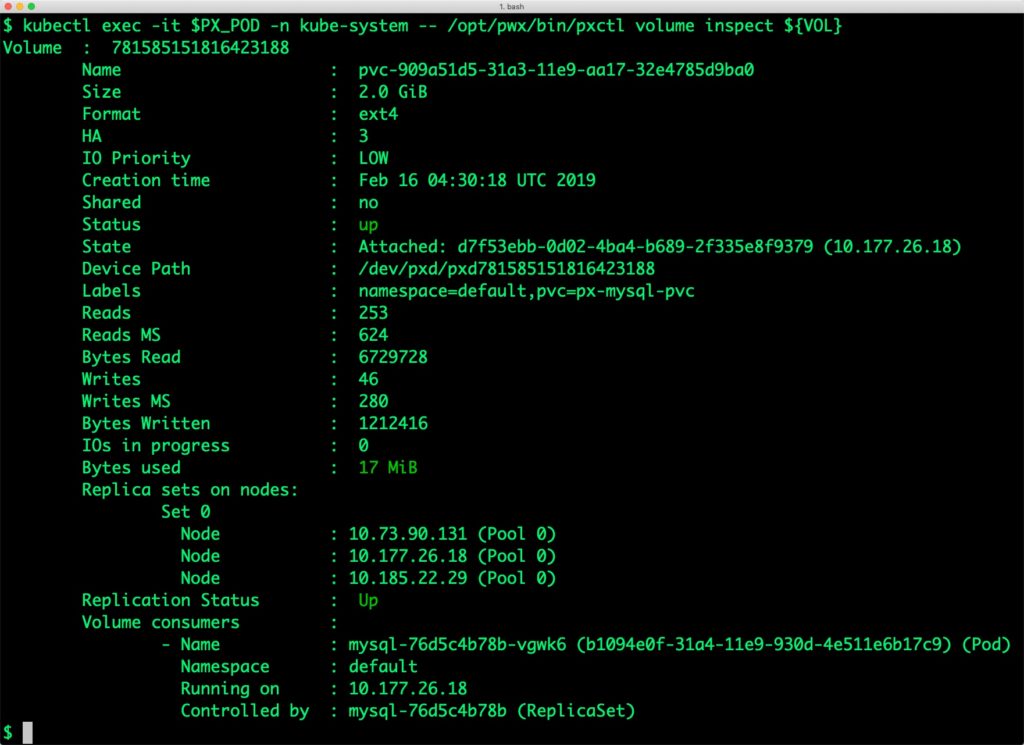
Taking Snapshots of a Kubernetes volume and restoring the database
Portworx supports creating snapshots for Kubernetes PVCs.
Let’s create a snapshot for the Kubernetes PVC we created for MySQL.
cat > px-mysql-snap.yaml << EOF apiVersion: volumesnapshot.external-storage.k8s.io/v1 kind: VolumeSnapshot metadata: name: px-mysql-snapshot namespace: default spec: persistentVolumeClaimName: px-mysql-pvc EOF
$ kubectl create -f px-mysql-snap.yaml volumesnapshot.volumesnapshot.external-storage.k8s.io/px-mysql-snapshot created
Verify the creation of volume snapshot.
$ kubectl get volumesnapshot NAME AGE px-mysql-snapshot 30s
$ kubectl get volumesnapshotdatas NAME AGE k8s-volume-snapshot-ce24471e-31a5-11e9-993d-eaa7125cd4d9 41s
With the snapshot in place, let’s go ahead and delete the database.
$ POD=`kubectl get pods -l app=mysql | grep Running | grep 1/1 | awk '{print $1}'`
$ kubectl exec -it $POD -- mysql -uroot -ppassword
drop database classicmodels;
Since snapshots are just like volumes, we can use it to start a new instance of MySQL. Let’s create a new instance of MySQL by restoring the snapshot data.
$ cat > px-mysql-snap-pvc << EOF
apiVersion: v1
kind: PersistentVolumeClaim
metadata:
name: px-mysql-snap-clone
annotations:
snapshot.alpha.kubernetes.io/snapshot: px-mysql-snapshot
spec:
accessModes:
- ReadWriteOnce
storageClassName: stork-snapshot-sc
resources:
requests:
storage: 2Gi
EOF
$ kubectl create -f px-mysql-snap-pvc.yaml
persistentvolumeclaim/px-mysql-snap-clone created
From the new PVC, we will create a MySQL pod.
$ cat < px-mysql-snap-restore.yaml >> EOF
apiVersion: apps/v1
kind: Deployment
metadata:
name: mysql-snap
spec:
selector:
matchLabels:
app: mysql-snap
strategy:
rollingUpdate:
maxSurge: 1
maxUnavailable: 1
type: RollingUpdate
replicas: 1
template:
metadata:
labels:
app: mysql-snap
spec:
affinity:
nodeAffinity:
requiredDuringSchedulingIgnoredDuringExecution:
nodeSelectorTerms:
- matchExpressions:
- key: px/running
operator: NotIn
values:
- "false"
- key: px/enabled
operator: NotIn
values:
- "false"
spec:
containers:
- name: mysql
image: mysql:5.6
imagePullPolicy: "Always"
env:
- name: MYSQL_ROOT_PASSWORD
value: password
ports:
- containerPort: 3306
volumeMounts:
- mountPath: /var/lib/mysql
name: mysql-data
volumes:
- name: mysql-data
persistentVolumeClaim:
claimName: px-mysql-snap-clone
EOF
$ kubectl create -f px-mysql-snap-restore.yaml deployment.extensions/mysql-snap created
Verify that the new pod is in a Running state.
$ kubectl get pods -l app=mysql-snap NAME READY STATUS RESTARTS AGE mysql-snap-9bb86fd6b-xpttx 1/1 Running 0 14s
Finally, let’s access the sample data created earlier in the walk-through.
$ POD=`kubectl get pods -l app=mysql-snap | grep Running | grep 1/1 | awk '{print $1}'`
$ kubectl exec -it $POD -- mysql -uroot -ppassword
mysql> USE `classicmodels`;
mysql> select `officeCode`, `city`, `phone` from `offices` where `country` = "USA";
+------------+---------------+-----------------+
| officeCode | city | phone |
+------------+---------------+-----------------+
| 1 | San Francisco | +1 650 219 4782 |
| 2 | Boston | +1 215 837 0825 |
| 3 | NYC | +1 212 555 3000 |
+------------+---------------+-----------------+
3 rows in set (0.00 sec)
Notice that the collection is still there with the data intact. We can also push the snapshot to an Amazon S3-compatible object storage service if we want to create a disaster recovery backup in another region or location. Since Portworx snapshots work with any S3 compatible object storage, the backup can go to a different cloud or even an on-premises data center.
Summary
Portworx can be easily deployed on IBM Cloud Kubernetes Service to run stateful workloads in production. Through the integration of STORK, DevOps and StorageOps teams can seamlessly run highly available database clusters in IKS. They can perform traditional operations such as volume expansion, backup, and recovery for the cloud native applications in an automated and efficient manner.
Share
Subscribe for Updates
About Us
Portworx is the leader in cloud native storage for containers.
Thanks for subscribing!

Janakiram MSV
Contributor | Certified Kubernetes Administrator (CKA) and Developer (CKAD)Explore Related Content:
- databases
- Ibm
- iks
- kubernetes
- mysql


